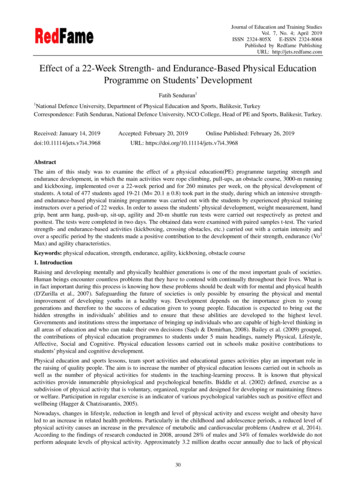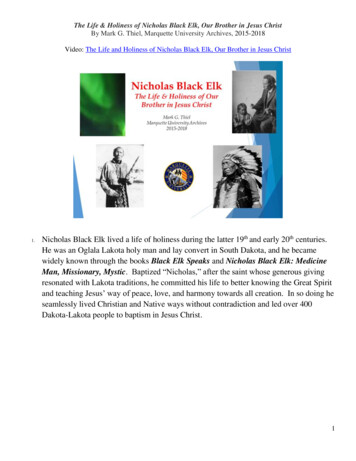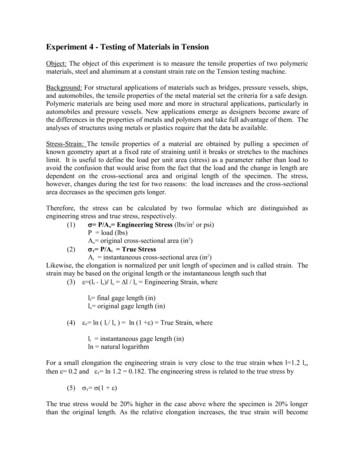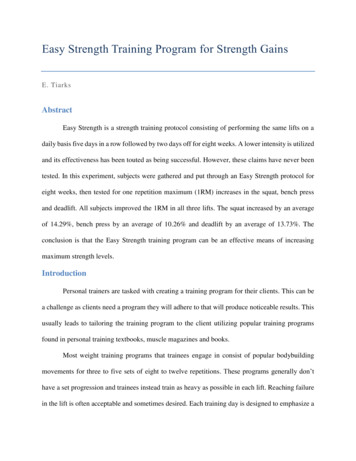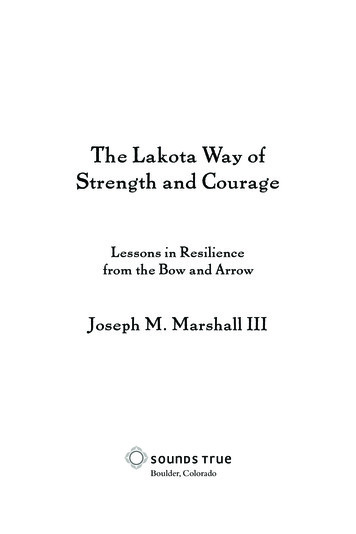
Transcription
The Lakota Way ofStrength and CourageLessons in Resiliencefrom the Bow and ArrowJoseph M. Marshall IIIBoulder, Colorado
Sounds True, Inc.Boulder, CO 80306 2012 Joseph M. Marshall IIISOUNDS TRUE is a trademark of Sounds True, Inc.All rights reserved. No part of this book may be used or reproduced in anymanner without written permission from the author and publisher.Cover and book design by Rachael MurrayPrinted in CanadaLibrary of Congress Cataloging-in-Publication DataMarshall, Joseph, 1945The Lakota way of strength and courage : lessons in resilience fromthe bow and arrow / Joseph M. Marshall III.p. cm.1. Teton Indians—History. 2. Teton philosophy. 3. TetonIndians—Social life and customs. I. Title.E99.T34.M36 2012978.004’975244—dc232011028292eBook ISBN 978-1-60407-747-610 9 8 7 6 5 4 3 2 1
ContentsIntroduction: Child of the Moon, Child of the SunxiChapter 1: Transformation1A Bag of StonesThe Conversations of Old MenThe Skill of the Bow Maker, the Resilience of the TreeTo Choose to ChangeFaces in the Water of ChangeChapter 2: Simplicity53Across the RiverThe Effectiveness of SimplicityChapter 3: Purpose75The Story KeeperThe Power of PurposeHonoring Purposeix
conte ntsChapter 4: Strength101Stone KnivesHeld to the FireNo Greater TreasureChapter 5: Resiliency131A Quiet WomanTo Go OnThe Best You HaveChapter 6: The Stone Carriers151Afterword: Parting Shots173Acknowledgments181About the Author183x
IntroductionChild of the Moon, Child of the SunThere was a time when Lakota boys looked at a new bowand arrows the way any modern teenager gazes at an iPod, a cellphone, or the latest version of a video game—longingly andlovingly. There was one basic difference, however. Lakota boyseventually learned how to make their own bows and arrows andlearned the life lessons associated with them.Bows and arrows have been around for thousands of yearsand, as weapons for hunting and warfare, were critical to thesurvival of cultures all over the world.They were frequently andliterally the difference between starvation and plenty and veryoften between life and death.Although I heard about the bow (itazipa) and the arrow(wahinkpe) in stories told by both of my maternal grandparents,I never actually saw the real thing until my grandfather madea set in 1950. The bow was of ash wood, and the arrows werethin chokecherry stalks. Like countless Lakota boys before me,I was immediately drawn to them. The feeling was somewhatlike meeting an old friend. More than likely, I felt an inherentcultural connection with them. My lifelong fascination beganthe moment my grandfather placed the arrows, one at a time,xi
the lakota way of stre ngth & courageon the bowstring and shot them into the air. As I watched thosefeathered shafts arc gracefully through the sky, I knew theywould be part of my life for as long as I lived.When I asked where the bow came from, it was my grandmother who replied.“From the moon,” she said.She explained that the moon was a woman, and it was shewho gave us Lakota the bow. I accepted what she said withoutquestion. Several evenings later, she showed me the sliver of anew moon hanging in the sky. The thin, silver crescent lookedexactly like my grandfather’s bow when he drew it back toshoot an arrow.According to my grandfather, someone in the distant pastsaw that same sliver of a new moon and related it to the function of a bow. A bow works by reacting to being drawn, or bent,when the archer pulls back on the string. When the string isreleased, the reflexive action launches the arrow. Anyone whois familiar with how a bow works, and especially anyone whohas constructed primitive bows, knows that the bow must bedesigned to withstand the stress of being drawn or bent. Baddesign or poor craftsmanship will cause one or both of thelimbs to work improperly or even break under stress.If nothing else, a primitive Lakota bow is the epitome ofsimplicity. When strung—that is, when the string is attached toboth tips—it resembles a narrow capital D. It is widest in themiddle, the point where the archer holds it. The length frombelow this handle to the tip is the bottom limb, or wing. Abovethe handle is the top limb. In order for the bow to functionsmoothly time after time, both limbs have to bend uniformly. Inother words, the stress has to be equal on both limbs.The thinnest sliver of a new moon also is widest in themiddle and gradually tapers to both ends. As my grandfathersaid, some archer in the distant past realized that he (or she)xii
Lakota ashwood bow with sinew string
the lakota way of stre ngth & couragewas looking at a design wherein the limbs of a bow would flex,or bend, evenly. Therefore, practically, as well as spiritually, themoon did give us the bow.Sooner or later, I asked the next obvious question: if the bowcame from the moon, where did the arrow come from?“From the sun,” was my grandfather’s reply.I already knew that the sun was considered a man, so Ideduced—correctly, as it turned out—that the arrow must bemale. One late afternoon, when the sun’s rays were shafts of lightdescending through a broken bank of clouds, my grandfatherpointed to them. Those were the arrows of the sun. While thebow was a graceful curve, the arrow was absolutely as straightas straight could be.Neither the moon nor the sun told us what sort of materialthe bow and arrow were to be made of. However, given thatmy Lakota ancestors harvested from the natural environmenteverything they used, wore, lived in, and ate, they knew thecharacteristics of every kind of raw material. Hardwoods wereused for bows because they were more flexible than softwoods,and both soft- and hardwood stalks were used for arrows.In pre-reservation days, bows and arrows were absolutenecessities for the Lakota hunter/warrior. He used that weaponset to procure the resources needed for food, shelter, and clothing, as well as to defend family, home, and community againstenemies. Around the age of twelve, every boy began to learnto craft them. It was a skill refined and polished year after year.There were usually a few who were much more skilled thanothers. Nevertheless, every man in the village was a bow makerand arrow smith.During the first years on the reservations, bows and arrowswere still being made and used for hunting. Some were madeto sell to whites, and several white collectors had been able toacquire some prior to the reservation era. There were still manyxiv
Lakota arrow with turkey feathers and iron point
the lakota way of stre ngth & couragemen of my grandparents’ generation, like my grandfather, whohad the knowledge and skills to make bows and arrows. Myfather had a basic knowledge, but as far as I know, he nevermade or used them. Technically speaking, the Lakota primitivebow and arrow have not been lost to history, but they have onlybarely survived.Various cultures look at the bow and arrow as more thanweapons, as more than the physical objects they are. That wascertainly true among my ancestors. Lakota archers, who individually crafted their own bows and arrows, looked at the beforeand after. They saw the bow and the arrow as a process. Andin that process they found the connections to, and associationswith, life. Over time, there emerged protocols and philosophiesregarding the crafting and use of bows and arrows.For example, when an oak, ash, or chokecherry tree was cutto make a bow, the bottom end of the tree was always marked.Therefore, the archer knew which end of the finished bowwould be the bottom and which would be the top.A single string notch was carved into the top tip, and twonotches were carved into the bottom tip, one on each side. Abow was kept unstrung, the string detached from the top limbnotch, until there was a reason to use it. Then the archer wouldstring the bow and, for a moment, perhaps a heartbeat, touchthe bottom of his bow to the earth. There was a simple but profound reason for that ritual. For that heartbeat in time, the bowwas realigned with the earth to connect it to the life-givingforce it had known when it was a living tree.There were similar rituals for the arrow. Like the bow wood,a stalk selected to be an arrow was marked at the bottom or rootend when cut. That end, the thickest part of the shaft, was thenock end, the end that was notched (usually in a vee) so that thefinished arrow could be placed on the string. When an archerwas about to shoot his first arrow, he placed, or nocked, thexvi
introduction: chi ld of the moon, chi ld of the sunarrow on the string. Then he lifted his bow to point the arrowvertically, in order to acknowledge the arrow’s configurationwhen it was a living stalk. If the archer was on foot, as opposedto mounted on a horse, he touched the nock end of the arrowto the ground before he placed it on the string.The reason for both the bow and arrow rituals was simple: thearcher, who was also the craftsman, demonstrated respect for theobjects, which were once living things, by briefly reconnecting orrealigning them with the life force of Grandmother Earth.Because of simple yet profound philosophies such as these,the basis for this book is the primitive version of the Lakotabow and arrow, used by my ancestors for hundreds of yearsbefore the Lakota people were forced to live on reservations.There were two basic kinds of bows and arrows: those used forhunting and those used for warfare.There were also the versionsused before my ancestors acquired the horse, and those adaptedor redesigned after the horse came. Whatever their historicalorigin, Lakota primitive bows and arrows were and are reflections of life, of the process that occurs from birth to death.When, as a boy, I watched my grandfather shoot his bow,and when he made a bow and arrows for me and put them inmy hand, little did I know my association with them would belifelong. Over the years, I have owned and used many bows. Butthe strongest sense of connection I feel is with the bows andarrows I make, because they reach across time. My skill and thehours of labor I spend making those bows and arrows put me inthe company of all the Lakota craftsmen and archers before mewho did the same. It is a circle, starting with them and endingwith me. The knowledge and ability to make a bow and anarrow came from them. And, like my ancestors, I have learnedlessons from those simple objects.The lessons were not simple, but were many and profound.I suspect there are more yet to come. A few have had a lastingxvii
the lakota way of stre ngth & courageimpact on me, as they have to do with issues that all of usencounter at some point in our lives, frequently more than once.For this book, I have selected five lessons: Transformation Simplicity Purpose Strength ResiliencyThese five are not all there is to life, but they are the lessonsfrom the bow and arrow that are most consistent for me. Ofthe five, one is a process, and the others are characteristics. Allcan be related directly to the art of making primitive bows andarrows, and to most things in life.xviii
and, as weapons for hunting and warfare, were critical to the survival of cultures all over the world. They were frequently and . if nothing else, a primitive Lakota bow is the epitome of simpli

